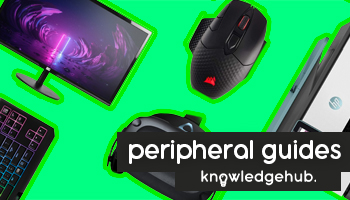The first thing you need to know is that there’s a best gaming mouse for every gamer, every budget, and even for every hand size. And don’t worry if you’re left-handed, there are mice for lefties too!
Selecting the best gaming mouse is important if you want to achieve your full competitive potential. A mouse is one of those overlooked peripherals which can easily be taken for granted. You’ve got the full blazing power of your PC ready to rumble, and all you need now is speedy and effective mouse to ensure none of it goes to waste!
When it comes to selecting a gaming mouse, you’ll be spoilt for choice as there are hundreds to pick from, and all of them sport lots of different features. The problem is that a mouse which is great for one person isn’t necessarily great for another.
Gaming mice aren’t just aesthetically different from the standard mouse you’ll find in the office. For a start, their sensors are designed to be more responsive and more accurate with little-to- no smoothing or acceleration, which can throw off your aim.
To fulfil your potential, your hands deserve the best gaming mouse along with the best keyboard. This means you’ll need to find a mouse which is comfortable and the right size and weight for your hand. For those of you who have special talents, there’s a good range of ambidextrous gaming mice available along with mice for left-handers.
GAMING MOUSE DEVELOPMENTS
In recent years, gaming mice have also adopted very accurate, high CPI (also called DPI) sensors. These determine how many dots (or virtual pixels) can be detected and read by the mouse. CPI revolves around how much the mouse cursor will move on-screen compared to physical movement detected on the pad. The higher the CPI, the further the cursor will move, requiring less effort on the user’s part. These days, even a budget mouse is likely to deliver an impressive performance in any game you play. And most of these sensors are capable of extremely high CPI counts such as 12,000 or more, when realistically you’ll play on a much lower sensitivity under 2,000.
Pro gamers generally recommend lighter, simpler mice, with fewer buttons to get in your way. Lighter mice will have less impact of your wrist as far as fatigue goes, and they are easy to shift across a mousepad at high speeds, which is vital. For a lightweight mouse, below 100 grams is ideal. If you prefer a heavy mouse there are many, many to choose from.
SO, WHAT MAKES THE BEST GAMING MOUSE?
All computer mice allow you to click, scroll and move a cursor. But what exactly makes one mouse better than another? Isn’t a gaming mouse, just a normal mouse with the word ‘gaming’ put in front of it? And if a gaming mouse really is different, what makes it different?
Firstly, gaming mice really are different. They are designed with specific aims in mind. Beyond reliability and responsive tracking, it’s customisation, comfort, and functionality. When all of your in-game attacking, navigating, and aiming is accomplished via a mouse, the mouse becomes a vital component to your gaming system.
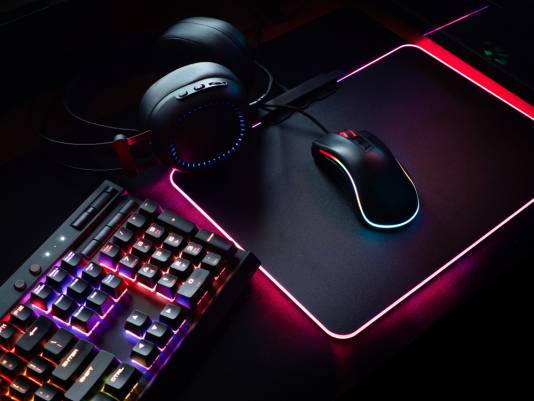
One of the most important qualities of a good mouse is its precision and accuracy. The kind of optical sensor and its resolution (measured in DPI) matters. These are considerations that are just not necessary with a standard computer mouse.
RESOLUTION (DPI)
The resolution of a mouse (measured in DPI) effectively controls how fast and accurately you can move the cursor. With this in mind, you may think that mice with higher DPI are better. This might be true in certain cases, but not in others. Sometimes different versions of mice will use the same optical sensor, but one mouse may achieve a higher DPI by dividing each pixel into four. It has a higher DPI rating, but this could cause a problem where the optical sensor begins to send errors due to signal noise. This can cause spurious motion where the mouse doesn’t move, but the cursor moves because the optical sensor is detecting the signal noise and interpreting it as motion.
This sounds like it’s getting very complicated… But in simple terms: Many of today’s mice come with an option to adjust DPI on-the-move, which means you can switch depending on what you need during your game. You can use fast-moving low DPI when you need extreme movement, or switch to slow-moving high DPI when you need control and accuracy for a shot.
LASER VERUS OPTICAL
The beating heart of a mouse is its sensor, and there are three basic types: laser, optical and infrared.
The laser sensor is probably the most common type of mouse, and a big advantage is that it is capable of working on almost any surface – soft or hard. However, laser mice tend to have a higher ‘lift-off’ distance than optical mice, which can cause issues as the mouse reaches the edge of your mousemat. The laser sensor carries on reading the surface as you lift the mouse to reposition it, until it’s anything up to a centimetre in the air, which is translated into in-game movements. By repositioning your mouse you can send your game view almost anywhere, which is obviously a very bad thing to do in the middle of a battle. A high-percentage of professional gamers prefer an optical mouse over laser and always play on a quality mousemat to ensure the optical sensor accurately reads the surface, as they need a consistent experience – if they can be distracted by technicalities during a game, they could easily lose the on-screen fight.
The introduction of the 3G infrared sensor is a new development which reduces the lift-off distance problems of a laser sensor, but is also very good at working on different surfaces. It’s definitely something to consider if you’re a serious gamer.
Shop gaming mice at Ebuyer
ERGONOMICS AND CUSTOMISATION
The ergonomics (comfort and efficiency) of a mouse are also very important factors. You could be using your mouse for long periods at a time so make sure it’s comfortable and has a good grip. High-end gaming mice will have removable weights so you can set the weight of your mouse. The centre of balance can also be adjusted on some models giving you a smoother experience. Many mice also feature additional buttons besides the click surfaces, giving you the power to program macro commands for quick weapon selection, etc. This is particularly useful in real-time strategy and MOBA games such as League of Legends and DOTA 2.
ARE THERE DIFFERENT TYPES OF GRIPS FOR GAMING?
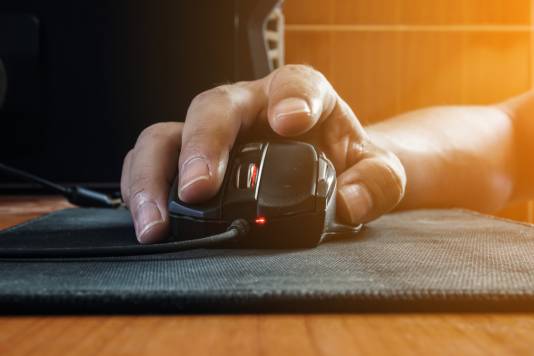
The answer is “Yes!” – there are three basic types of grip which are popular with gamers. The type of grip you use can affect your performance. It may seem like we’re getting into professional gaming territory here, but all these little things add up to one bigger thing: Gaming success! Here are the three main grips:
- The Palm grip: This is how most people hold their mouse. Your entire hand lies flat on the mouse.
- The Claw grip: This one is like the palm grip, but your fingers are arched in the shape of a claw.
- The Fingertip grip: The entire mouse is held with just your fingertips. Your palm doesn’t touch the mouse at all.
CLAW GRIP VERSUS PALM GRIP
The two most popular grips (out of the three mentioned above) are the claw and palm grips.
The claw grip, where the mouse is held by the tips of the fingers and is (almost) lifted across the surface of the mousemat, favours small and light mice. The palm grip, where the palm of the hand rests on the top of the mouse and pushes it along the mousemat, is more suited to large mice.
Some mice will satisfy both sorts of grip, but some are more appropriate to one or the other. For example, Razer have produced a number of mice that are small and well suited to the claw-grip. Logitech, on the other hand, tend to design larger mice that are more comfortable for palm-grip users.
FIND OUT THE DPI SWEETSPOT
Finding your perfect sensitivity is important. As we’ve mentioned, DPI is basically how sensitive your mouse is. All the superior gaming mice (Razer, Corsair, Roccat, Logitech) have a mouse tuning software, so set your DPI to your sweet spot and feel the difference.
WHAT KIND OF GAMES DO YOU PLAY?
Do you mainly play FPS (First Person Shooter) games? RTS (Real Time Strategy)? MMO (Massively Multiplayer Online)? Most mice cater to FPS games, but there are also mice that have more buttons and macros designed specifically for RTS games and MMO’s.
IT’S A ‘TWO MAIN BUTTON’ THING!
Look at the two main buttons on your mouse. If they don’t look distinguished and the mouse looks like it’s on the large side, it’s probably a mouse designed for the palm-grip. If the two main buttons are clearly indented or visible in some way and the mouse is relatively small, then you can assume that it’s meant for finger and claw-grip players.
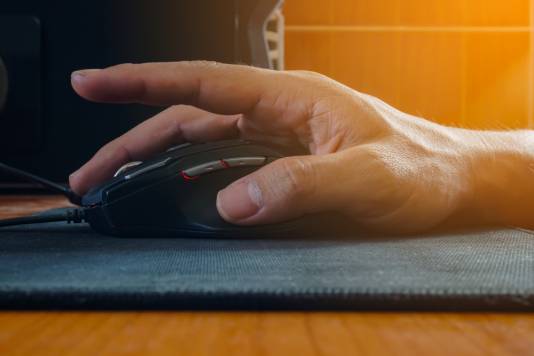
HOW TO CHOOSE THE BEST GAMING MOUSE FOR YOU?
Choosing the best gaming mouse can be quite a difficult task as there are so many on the market, all claiming to give you the extra edge. Here are a few things to help you decide…
WHAT DO YOU WANT YOUR MOUSE TO DO?
The first thing to do is work out what you want the mouse for. What types of games will you be playing? Do you prefer FPS, RPG or RTS games? If the answer is first-person shooters (FPS) then you’ve got the hardest choice to make as you’ll need to work out what sort of player you are – you’ve probably never even asked yourself that question, have you? (See the section below about DPI).
If you’re the kind of player who loves strategy, RPG or MMO games then the choice is a bit more straight-forward, as you should be looking for a mouse with a large number of programmable buttons and a DPI which suits your playing style. Some mice have ten buttons or more.
LET’S TALK DPI…
On the packaging of every gaming mouse you’ll be informed of the mouse’s sensitivity. This will be a value rated in DPI, or Dots Per Inch, and is a simplistic way of measuring the sensitivity of a mouse sensor.
The higher the DPI of the sensor the less physical distance you need to move the mouse to get the same level of cursor movement on screen. So, if you have a high DPI mouse, you can be more economical with your hand movements. This means that you need to have a steady hand and be very precise to make accurate cursor movements.
Armed with that information, you need to decide if you’re the sort of gamer who likes to make fast sweeping hand movements over a large area, or slower more precise movements over a small area. Try it and see how you feel!

If you prefer fast hand movements then you need a mouse with a low DPI to maintain some level of accuracy (perhaps 1,200 DPI or less), whereas a player with small hand movements can use a mouse with higher DPI and remain accurate (say 2,000 DPI or more).
It’s for this reason that you need to be wary of the marketing hype (and prices) surrounding high DPI mice. Most of the premium mice are capable of around 5,000 DPI and some manufacturers have started pushing their mice to 6,400DPI.
If you start making fast movements at that level of DPI you’re going to find yourself in a big trouble in a FPS. Make sure your mouse has adjustable DPI and then drop it to around 2,000 (or even lower for some pro-gamers) and you’ll be more likely to find the perfect setting.
Shop gaming mice at Ebuyer
WIRED OR WIRELESS?
Wireless mice are great for reducing the tangle of wires on your desk, but the reliance on radio waves to transmit the signal to the receiver does add some delay (known as lag) to the cursor response. If you really want the absolute fastest response then you should stick to a corded mouse, even though in all honestly most modern wireless mice these days are almost lag-free.
Wireless mice are also compromised by their reliance on batteries. And guess what? Batteries always need replacing when you’re right in the middle of a gun-fight!
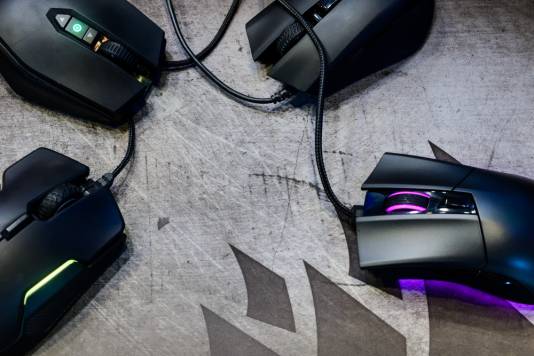
Batteries also make your mouse a little heavier, so if you really prefer a lighter mouse, a wireless one might not be the choice for you.
The latest generation of wireless mice use a detachable USB cable to provide maximum convenience. You get the freedom of a wireless mouse but the convenience of recharging via a cable. So, there’s no need to mess about with batteries, and no additional costs.
LEFT HANDED OR RIGHT HANDED?
Left-handed people aren’t weird (or geniuses come to that) but if you happen to be a left-handed gamer then you will definitely find that your choices are more limited. The vast majority of ergonomically designed gaming mice are for right-handed gamers only, but there are lots to choose from if you’re content to use a mouse with an ambidextrous design.
You will probably find a few left-handed mice on offer, but these generally fall short of the requirements for a good gaming mouse (few buttons, low DPI).
TOUGH AND DURABLE. CAN YOUR MOUSE STAND THE HEAT?
A good gaming mouse is one that can take a real hammering. After all, gaming is a lot more physical than people think. The frantic action of a FPS can lead to excessive pressure being used on the mouse and its buttons, and this tough play will eventually lead to some sort of failure. Gaming mice are built to withstand more punishment than standard mice, but if they are ‘played hard’ regularly, they might not last longer than a few months. It just depends how physical you get in the heat of battle!
Some mice are much tougher than orders. It’s a survival of the fittest thing! The Logitech MX518 is still popular even though it’s been around for quite a while, as it a reputation for being able to take a lot of punishment.
SEE THE LIGHT
Cool lighting on mice seems to be all the fashion. More mice are including some form of LED illumination and the styles are becoming ever more sophisticated. Mouse lights can be configured to glow different colours and rotate and pulse in various patterns. Some manufacturers offer a single colour but allow you to choose from a variety of hues.

Fancy lighting won’t make you a better gamer, but it will make your mouse look super-cool.
DO YOU GET WHAT YOU PAY FOR?
Generally, you do. However, there’s really no point in spending a large amount of money on an all-singing-all-dancing mouse if it’s one that doesn’t suit your gaming style. It may look amazing but it might not contribute anything to how you game. In fact, it could make you less effective!
The best thing to do is think about which mouse you want first and then see if it fits into your budget.
IT’S PERSONAL!
The final thing to consider is that choosing a gaming mouse is a very personal decision. We all have our preferences when it comes to the look and feel of a product, and that will influence your decision. You may be determined to get a mouse with flashy lighting such as a Razer mouse, and there’s nothing wrong with that, or you may go for something which is more functional, such as a Logitech. There’s no right or wrong answer, you’ll know in your own mind what you want.

HOW DID YOU DO?
There isn’t one particular mouse which can be crowned ‘the best gaming mouse’ – but there are lots of great mice which will provide everything you need for effective gaming.
The look of the mouse you like the most will be a very personal decision. Probably the best thing you can do is come up with a shortlist of mice that really think will fit the bill for what YOU want. Don’t stick with a brand just for the sake of it, as there are lots of great manufacturers out there producing fantastic mice.
Look at customer reviews, look at the deal you can get and then make your decision. A little bit of thought can make a big difference to your gaming.


